KIA Sorento 2006 1.G Owner's Manual
Manufacturer: KIA, Model Year: 2006, Model line: Sorento, Model: KIA Sorento 2006 1.GPages: 312, PDF Size: 5.21 MB
Page 201 of 312
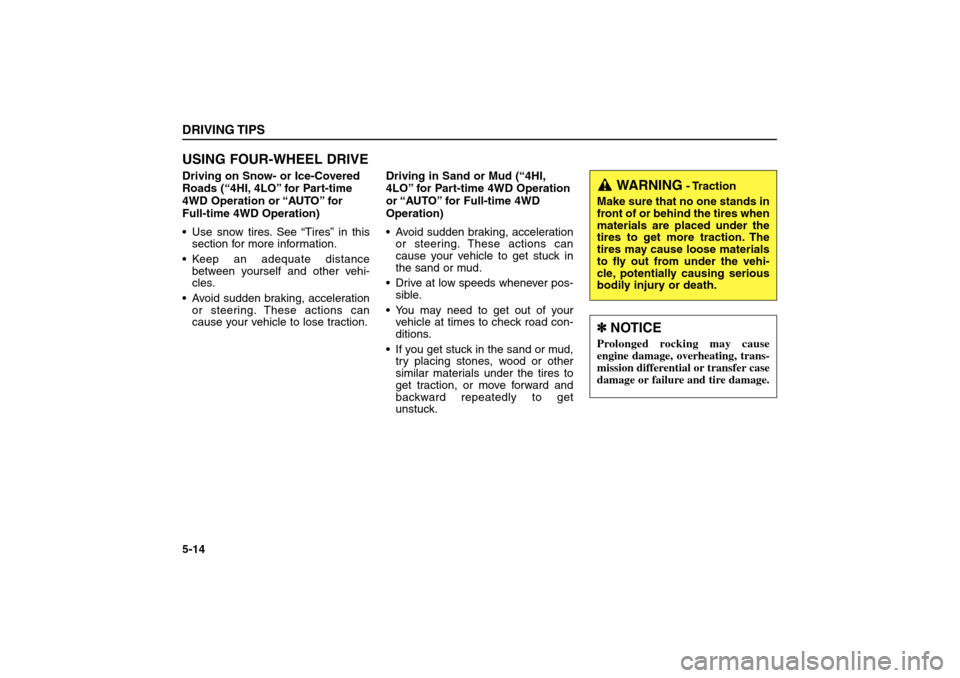
USING FOUR-WHEEL DRIVEDriving on Snow- or Ice-Covered
Roads (“4HI, 4LO” for Part-time
4WD Operation or “AUTO” for
Full-time 4WD Operation)
Use snow tires. See “Tires” in this
section for more information.
Keep an adequate distance
between yourself and other vehi-
cles.
Avoid sudden braking, acceleration
or steering. These actions can
cause your vehicle to lose traction.Driving in Sand or Mud (“4HI,
4LO” for Part-time 4WD Operation
or “AUTO” for Full-time 4WD
Operation)
Avoid sudden braking, acceleration
or steering. These actions can
cause your vehicle to get stuck in
the sand or mud.
Drive at low speeds whenever pos-
sible.
You may need to get out of your
vehicle at times to check road con-
ditions.
If you get stuck in the sand or mud,
try placing stones, wood or other
similar materials under the tires to
get traction, or move forward and
backward repeatedly to get
unstuck.DRIVING TIPS5-14
WARNING
- Traction
Make sure that no one stands in
front of or behind the tires when
materials are placed under the
tires to get more traction. The
tires may cause loose materials
to fly out from under the vehi-
cle, potentially causing serious
bodily injury or death.
✽ ✽
NOTICEProlonged rocking may cause
engine damage, overheating, trans-
mission differential or transfer case
damage or failure and tire damage.
BL-ENG (CAN)-5.qxd 7/28/05 5:56 PM Page 14
Page 202 of 312
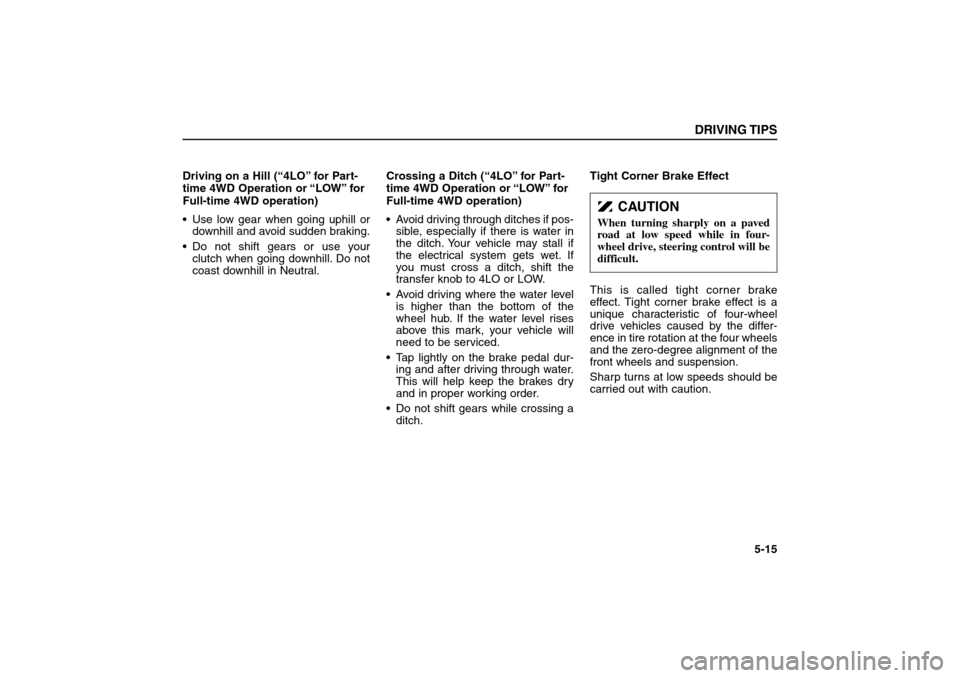
Driving on a Hill (“4LO” for Part-
time 4WD Operation or “LOW” for
Full-time 4WD operation)
Use low gear when going uphill or
downhill and avoid sudden braking.
Do not shift gears or use your
clutch when going downhill. Do not
coast downhill in Neutral.Crossing a Ditch (“4LO” for Part-
time 4WD Operation or “LOW” for
Full-time 4WD operation)
Avoid driving through ditches if pos-
sible, especially if there is water in
the ditch. Your vehicle may stall if
the electrical system gets wet. If
you must cross a ditch, shift the
transfer knob to 4LO or LOW.
Avoid driving where the water level
is higher than the bottom of the
wheel hub. If the water level rises
above this mark, your vehicle will
need to be serviced.
Tap lightly on the brake pedal dur-
ing and after driving through water.
This will help keep the brakes dry
and in proper working order.
Do not shift gears while crossing a
ditch.Tight Corner Brake Effect
This is called tight corner brake
effect. Tight corner brake effect is a
unique characteristic of four-wheel
drive vehicles caused by the differ-
ence in tire rotation at the four wheels
and the zero-degree alignment of the
front wheels and suspension.
Sharp turns at low speeds should be
carried out with caution.
DRIVING TIPS
5-15
CAUTION
When turning sharply on a paved
road at low speed while in four-
wheel drive, steering control will be
difficult.
BL-ENG (CAN)-5.qxd 7/28/05 5:56 PM Page 15
Page 203 of 312
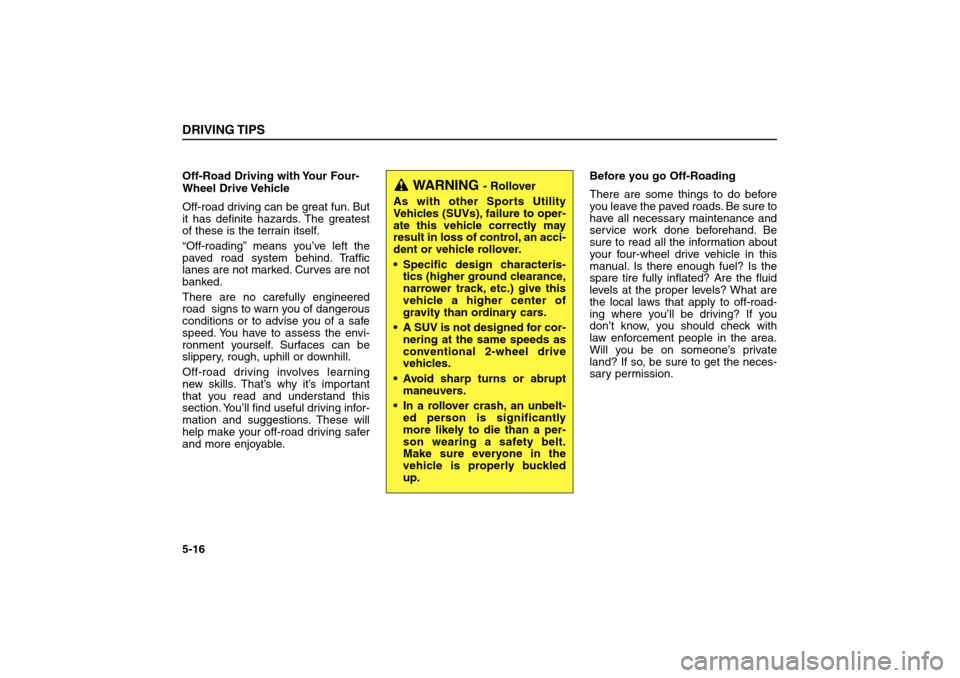
Off-Road Driving with Your Four-
Wheel Drive Vehicle
Off-road driving can be great fun. But
it has definite hazards. The greatest
of these is the terrain itself.
“Off-roading” means you’ve left the
paved road system behind. Traffic
lanes are not marked. Curves are not
banked.
There are no carefully engineered
road signs to warn you of dangerous
conditions or to advise you of a safe
speed. You have to assess the envi-
ronment yourself. Surfaces can be
slippery, rough, uphill or downhill.
Off-road driving involves learning
new skills. That’s why it’s important
that you read and understand this
section. You’ll find useful driving infor-
mation and suggestions. These will
help make your off-road driving safer
and more enjoyable.Before you go Off-Roading
There are some things to do before
you leave the paved roads. Be sure to
have all necessary maintenance and
service work done beforehand. Be
sure to read all the information about
your four-wheel drive vehicle in this
manual. Is there enough fuel? Is the
spare tire fully inflated? Are the fluid
levels at the proper levels? What are
the local laws that apply to off-road-
ing where you’ll be driving? If you
don’t know, you should check with
law enforcement people in the area.
Will you be on someone’s private
land? If so, be sure to get the neces-
sary permission.DRIVING TIPS5-16
WARNING
- Rollover
As with other Sports Utility
Vehicles (SUVs), failure to oper-
ate this vehicle correctly may
result in loss of control, an acci-
dent or vehicle rollover.
Specific design characteris-
tics (higher ground clearance,
narrower track, etc.) give this
vehicle a higher center of
gravity than ordinary cars.
A SUV is not designed for cor-
nering at the same speeds as
conventional 2-wheel drive
vehicles.
Avoid sharp turns or abrupt
maneuvers.
In a rollover crash, an unbelt-
ed person is significantly
more likely to die than a per-
son wearing a safety belt.
Make sure everyone in the
vehicle is properly buckled
up.
BL-ENG (CAN)-5.qxd 7/28/05 5:56 PM Page 16
Page 204 of 312
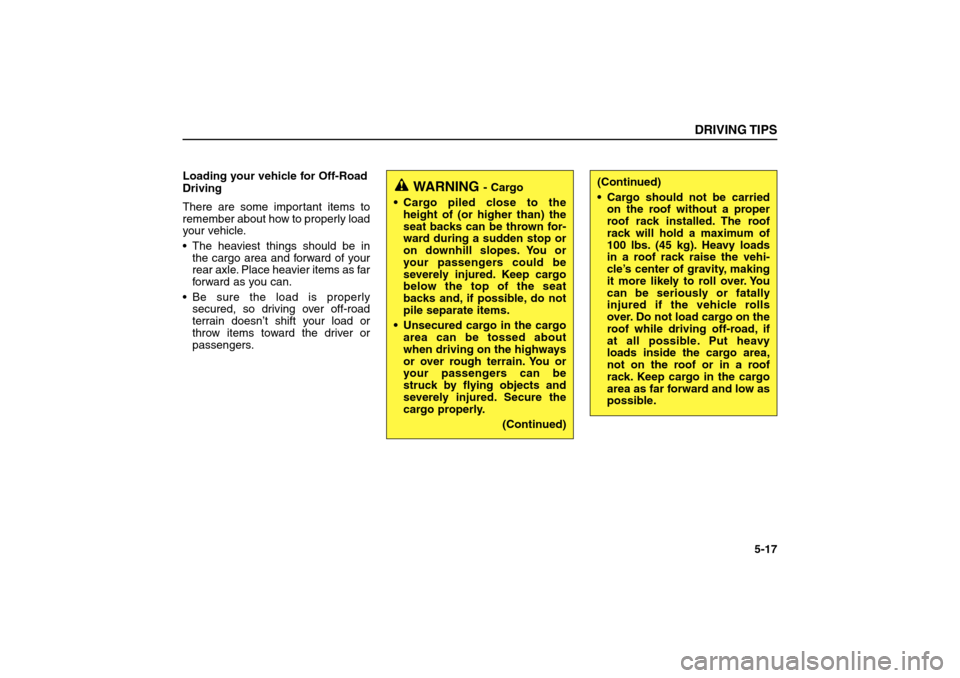
Loading your vehicle for Off-Road
Driving
There are some important items to
remember about how to properly load
your vehicle.
The heaviest things should be in
the cargo area and forward of your
rear axle. Place heavier items as far
forward as you can.
Be sure the load is properly
secured, so driving over off-road
terrain doesn’t shift your load or
throw items toward the driver or
passengers.
DRIVING TIPS
5-17
WARNING
- Cargo
Cargo piled close to the
height of (or higher than) the
seat backs can be thrown for-
ward during a sudden stop or
on downhill slopes. You or
your passengers could be
severely injured. Keep cargo
below the top of the seat
backs and, if possible, do not
pile separate items.
Unsecured cargo in the cargo
area can be tossed about
when driving on the highways
or over rough terrain. You or
your passengers can be
struck by flying objects and
severely injured. Secure the
cargo properly.
(Continued)
(Continued)
Cargo should not be carried
on the roof without a proper
roof rack installed. The roof
rack will hold a maximum of
100 lbs. (45 kg). Heavy loads
in a roof rack raise the vehi-
cle’s center of gravity, making
it more likely to roll over. You
can be seriously or fatally
injured if the vehicle rolls
over. Do not load cargo on the
roof while driving off-road, if
at all possible. Put heavy
loads inside the cargo area,
not on the roof or in a roof
rack. Keep cargo in the cargo
area as far forward and low as
possible.
BL-ENG (CAN)-5.qxd 7/28/05 5:56 PM Page 17
Page 205 of 312
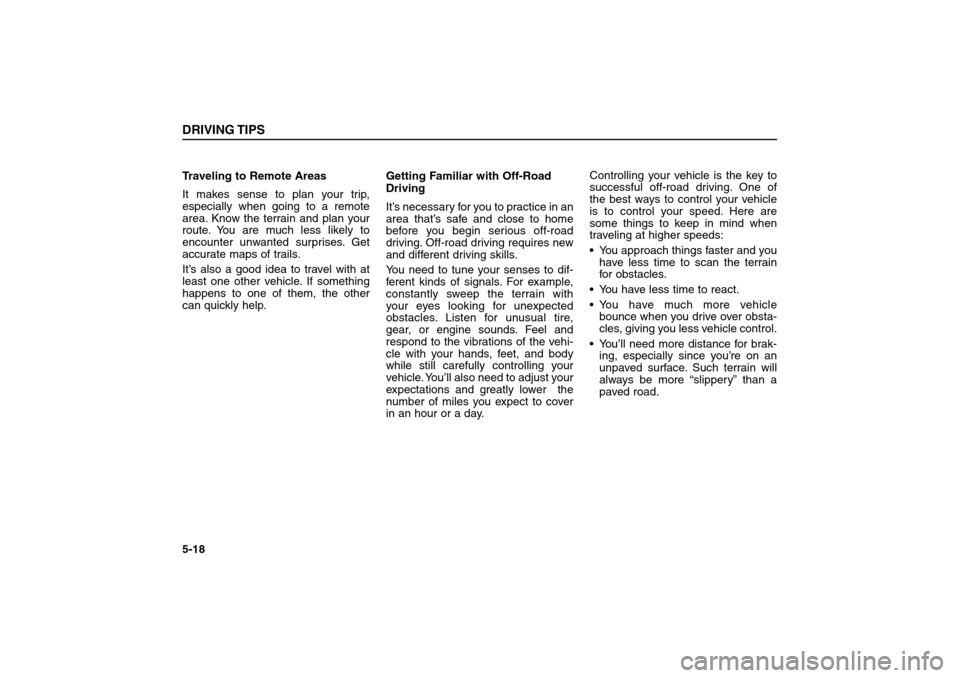
Traveling to Remote Areas
It makes sense to plan your trip,
especially when going to a remote
area. Know the terrain and plan your
route. You are much less likely to
encounter unwanted surprises. Get
accurate maps of trails.
It’s also a good idea to travel with at
least one other vehicle. If something
happens to one of them, the other
can quickly help.Getting Familiar with Off-Road
Driving
It’s necessary for you to practice in an
area that’s safe and close to home
before you begin serious off-road
driving. Off-road driving requires new
and different driving skills.
You need to tune your senses to dif-
ferent kinds of signals. For example,
constantly sweep the terrain with
your eyes looking for unexpected
obstacles. Listen for unusual tire,
gear, or engine sounds. Feel and
respond to the vibrations of the vehi-
cle with your hands, feet, and body
while still carefully controlling your
vehicle. You’ll also need to adjust your
expectations and greatly lower the
number of miles you expect to cover
in an hour or a day.Controlling your vehicle is the key to
successful off-road driving. One of
the best ways to control your vehicle
is to control your speed. Here are
some things to keep in mind when
traveling at higher speeds:
You approach things faster and you
have less time to scan the terrain
for obstacles.
You have less time to react.
You have much more vehicle
bounce when you drive over obsta-
cles, giving you less vehicle control.
You’ll need more distance for brak-
ing, especially since you’re on an
unpaved surface. Such terrain will
always be more “slippery” than a
paved road.DRIVING TIPS5-18
BL-ENG (CAN)-5.qxd 7/28/05 5:56 PM Page 18
Page 206 of 312
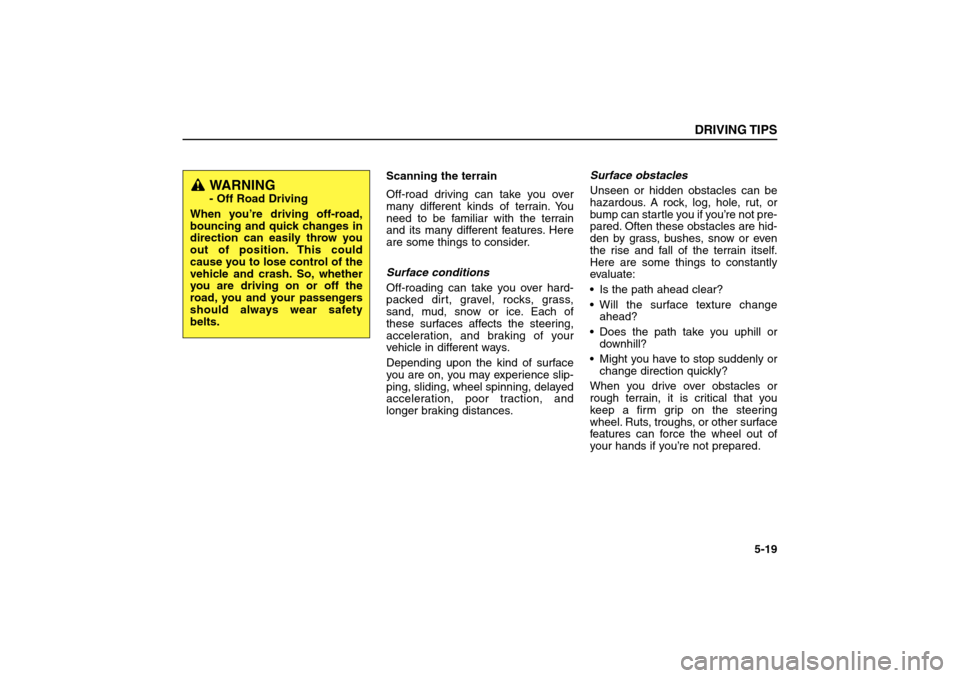
Scanning the terrain
Off-road driving can take you over
many different kinds of terrain. You
need to be familiar with the terrain
and its many different features. Here
are some things to consider.
Surface conditions
Off-roading can take you over hard-
packed dirt, gravel, rocks, grass,
sand, mud, snow or ice. Each of
these surfaces affects the steering,
acceleration, and braking of your
vehicle in different ways.
Depending upon the kind of surface
you are on, you may experience slip-
ping, sliding, wheel spinning, delayed
acceleration, poor traction, and
longer braking distances.Surface obstacles
Unseen or hidden obstacles can be
hazardous. A rock, log, hole, rut, or
bump can startle you if you’re not pre-
pared. Often these obstacles are hid-
den by grass, bushes, snow or even
the rise and fall of the terrain itself.
Here are some things to constantly
evaluate:
Is the path ahead clear?
Will the surface texture change
ahead?
Does the path take you uphill or
downhill?
Might you have to stop suddenly or
change direction quickly?
When you drive over obstacles or
rough terrain, it is critical that you
keep a firm grip on the steering
wheel. Ruts, troughs, or other surface
features can force the wheel out of
your hands if you’re not prepared.
DRIVING TIPS
5-19
WARNING- Off Road Driving
When you’re driving off-road,
bouncing and quick changes in
direction can easily throw you
out of position. This could
cause you to lose control of the
vehicle and crash. So, whether
you are driving on or off the
road, you and your passengers
should always wear safety
belts.
BL-ENG (CAN)-5.qxd 7/28/05 5:56 PM Page 19
Page 207 of 312
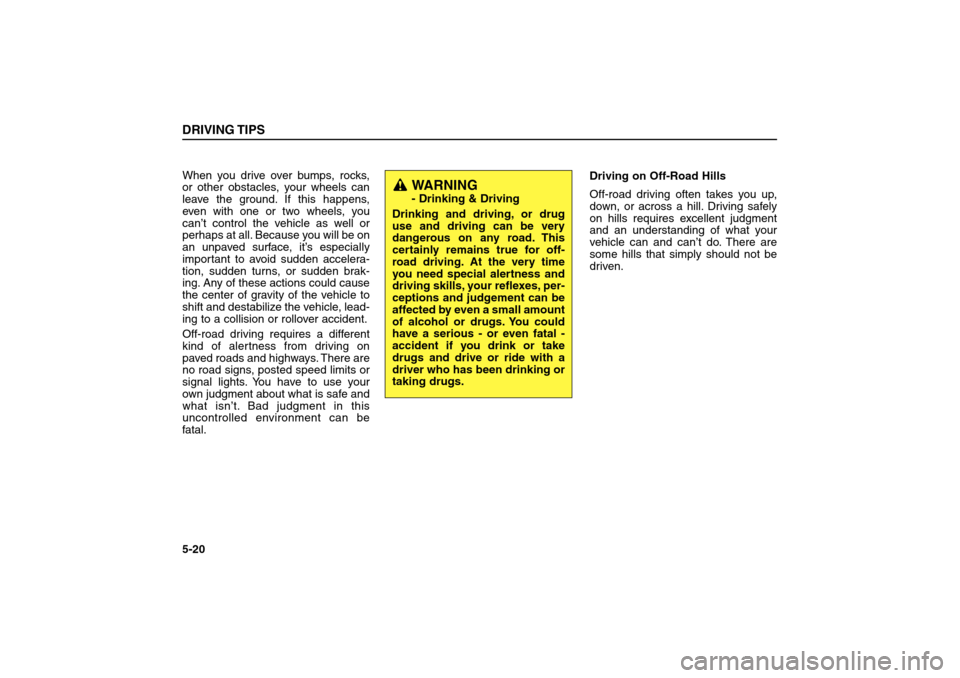
When you drive over bumps, rocks,
or other obstacles, your wheels can
leave the ground. If this happens,
even with one or two wheels, you
can’t control the vehicle as well or
perhaps at all. Because you will be on
an unpaved surface, it’s especially
important to avoid sudden accelera-
tion, sudden turns, or sudden brak-
ing. Any of these actions could cause
the center of gravity of the vehicle to
shift and destabilize the vehicle, lead-
ing to a collision or rollover accident.
Off-road driving requires a different
kind of alertness from driving on
paved roads and highways. There are
no road signs, posted speed limits or
signal lights. You have to use your
own judgment about what is safe and
what isn’t. Bad judgment in this
uncontrolled environment can be
fatal.Driving on Off-Road Hills
Off-road driving often takes you up,
down, or across a hill. Driving safely
on hills requires excellent judgment
and an understanding of what your
vehicle can and can’t do. There are
some hills that simply should not be
driven.DRIVING TIPS5-20
WARNING- Drinking & Driving
Drinking and driving, or drug
use and driving can be very
dangerous on any road. This
certainly remains true for off-
road driving. At the very time
you need special alertness and
driving skills, your reflexes, per-
ceptions and judgement can be
affected by even a small amount
of alcohol or drugs. You could
have a serious - or even fatal -
accident if you drink or take
drugs and drive or ride with a
driver who has been drinking or
taking drugs.
BL-ENG (CAN)-5.qxd 7/28/05 5:56 PM Page 20
Page 208 of 312
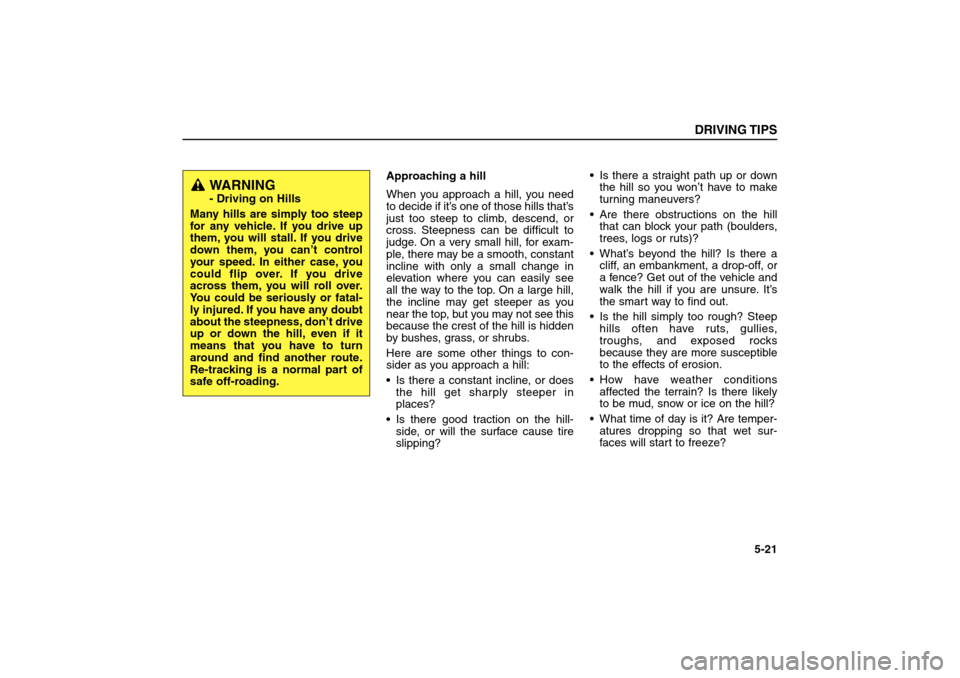
Approaching a hill
When you approach a hill, you need
to decide if it’s one of those hills that’s
just too steep to climb, descend, or
cross. Steepness can be difficult to
judge. On a very small hill, for exam-
ple, there may be a smooth, constant
incline with only a small change in
elevation where you can easily see
all the way to the top. On a large hill,
the incline may get steeper as you
near the top, but you may not see this
because the crest of the hill is hidden
by bushes, grass, or shrubs.
Here are some other things to con-
sider as you approach a hill:
Is there a constant incline, or does
the hill get sharply steeper in
places?
Is there good traction on the hill-
side, or will the surface cause tire
slipping? Is there a straight path up or down
the hill so you won’t have to make
turning maneuvers?
Are there obstructions on the hill
that can block your path (boulders,
trees, logs or ruts)?
What’s beyond the hill? Is there a
cliff, an embankment, a drop-off, or
a fence? Get out of the vehicle and
walk the hill if you are unsure. It’s
the smart way to find out.
Is the hill simply too rough? Steep
hills often have ruts, gullies,
troughs, and exposed rocks
because they are more susceptible
to the effects of erosion.
How have weather conditions
affected the terrain? Is there likely
to be mud, snow or ice on the hill?
What time of day is it? Are temper-
atures dropping so that wet sur-
faces will start to freeze?
DRIVING TIPS
5-21
WARNING- Driving on Hills
Many hills are simply too steep
for any vehicle. If you drive up
them, you will stall. If you drive
down them, you can’t control
your speed. In either case, you
could flip over. If you drive
across them, you will roll over.
You could be seriously or fatal-
ly injured. If you have any doubt
about the steepness, don’t drive
up or down the hill, even if it
means that you have to turn
around and find another route.
Re-tracking is a normal part of
safe off-roading.
BL-ENG (CAN)-5.qxd 7/28/05 5:56 PM Page 21
Page 209 of 312
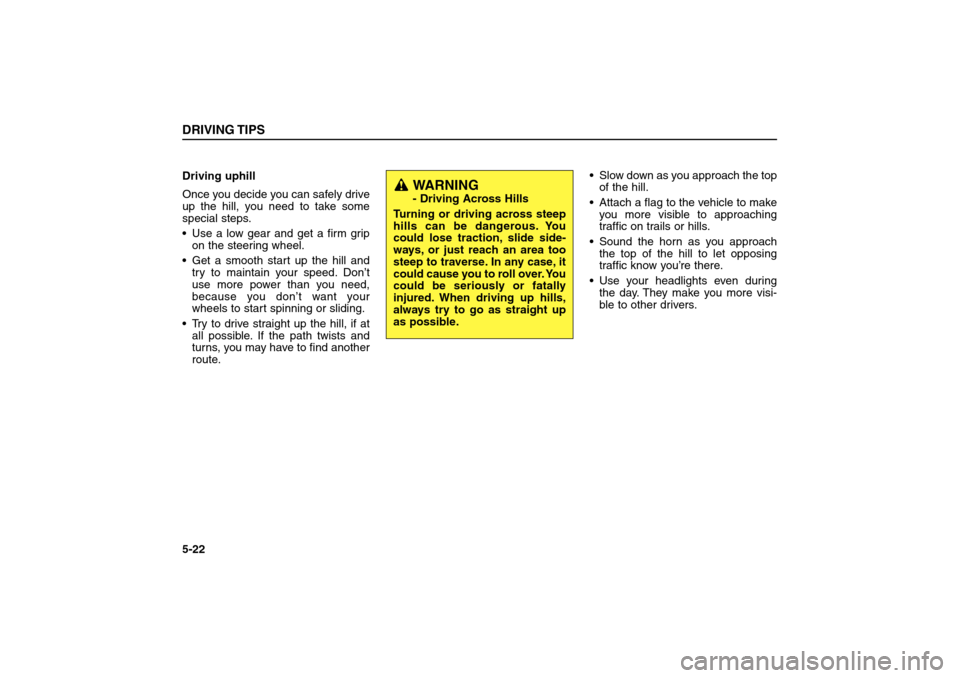
Driving uphill
Once you decide you can safely drive
up the hill, you need to take some
special steps.
Use a low gear and get a firm grip
on the steering wheel.
Get a smooth start up the hill and
try to maintain your speed. Don’t
use more power than you need,
because you don’t want your
wheels to start spinning or sliding.
Try to drive straight up the hill, if at
all possible. If the path twists and
turns, you may have to find another
route. Slow down as you approach the top
of the hill.
Attach a flag to the vehicle to make
you more visible to approaching
traffic on trails or hills.
Sound the horn as you approach
the top of the hill to let opposing
traffic know you’re there.
Use your headlights even during
the day. They make you more visi-
ble to other drivers.DRIVING TIPS5-22
WARNING- Driving Across Hills
Turning or driving across steep
hills can be dangerous. You
could lose traction, slide side-
ways, or just reach an area too
steep to traverse. In any case, it
could cause you to roll over. You
could be seriously or fatally
injured. When driving up hills,
always try to go as straight up
as possible.
BL-ENG (CAN)-5.qxd 7/28/05 5:56 PM Page 22
Page 210 of 312
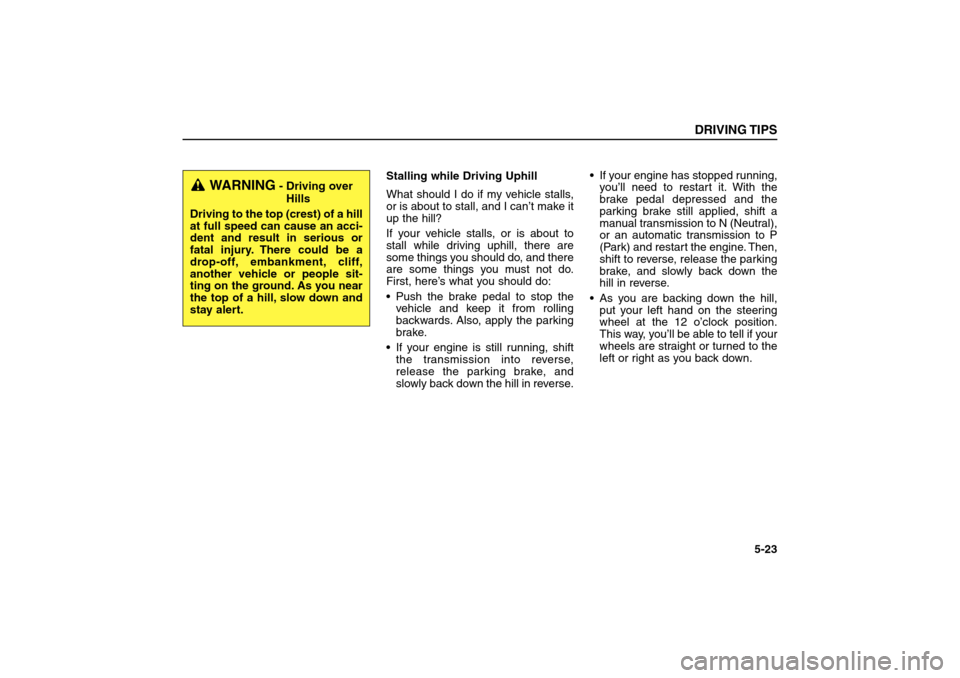
Stalling while Driving Uphill
What should I do if my vehicle stalls,
or is about to stall, and I can’t make it
up the hill?
If your vehicle stalls, or is about to
stall while driving uphill, there are
some things you should do, and there
are some things you must not do.
First, here’s what you should do:
Push the brake pedal to stop the
vehicle and keep it from rolling
backwards. Also, apply the parking
brake.
If your engine is still running, shift
the transmission into reverse,
release the parking brake, and
slowly back down the hill in reverse. If your engine has stopped running,
you’ll need to restart it. With the
brake pedal depressed and the
parking brake still applied, shift a
manual transmission to N (Neutral),
or an automatic transmission to P
(Park) and restart the engine. Then,
shift to reverse, release the parking
brake, and slowly back down the
hill in reverse.
As you are backing down the hill,
put your left hand on the steering
wheel at the 12 o’clock position.
This way, you’ll be able to tell if your
wheels are straight or turned to the
left or right as you back down.
DRIVING TIPS
5-23
WARNING
- Driving over
Hills
Driving to the top (crest) of a hill
at full speed can cause an acci-
dent and result in serious or
fatal injury. There could be a
drop-off, embankment, cliff,
another vehicle or people sit-
ting on the ground. As you near
the top of a hill, slow down and
stay alert.
BL-ENG (CAN)-5.qxd 7/28/05 5:56 PM Page 23